Loading Models
Loading a new model clears any existing model on the workspace after prompting the user for verification. In the case of a blank workspace, no verification is needed.
Opening Models and Files Using the Quick Start
The Quick Start window is displayed on top of the workspace when RiverWare is opened. It provides two primary actions:
• Start with empty workspace - Close the Quick Start window without opening or loading any items.
• Select existing files to open - Open the selected model and optionally other files.
Figure 3.1 Quick Start window when first opened. The two main options are highlighted with the red rectangle.
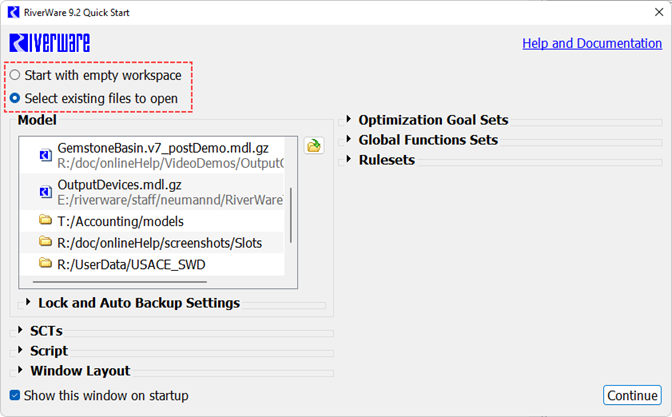
The Quick Start contains sections that allow the selection of a model, model settings for locking and auto backup and one or more SCTs, global functions sets, rulesets, and optimization goal sets. Only a model selection is required to select the Continue button.
Tip: You can double click a model file to immediately opening it.
The Quick Start window can be reopened from the File and then Open Quick Start… menu from the workspace. In this case, The Start with empty workspace option will instead read Do not open model. For that option, the Quick Start is closed and no new model is opened and the workspace is not cleared.
If you don’t want to see this dialog in the future, use the Show this window on startup option at the bottom of the dialog. This option is saved as a user setting. To show the dialog again, from the workspace, select File and then Open Quick Start menu. Re select the check box.
Tip: The start window also contains a Help and Documentation link in the top right corner that opens the help and documentation in a browser.
Note: This window is not displayed when RiverWare is opened in batch mode or if a model is specified with the --model command line argument.
The remainder of this section describes the selections; first select a Model and then optionally any locking or backup save settings. Then select SCTs, Scripts to run, Window Layouts, Global Function Sets, Rulesets, and/or Optimization Goal Sets. The following figure shows the dialog with most of the sections expanded.
Figure 3.2 The Quick Start window with most sections expanded and informational labels indicating which item types are already present in the selected model.
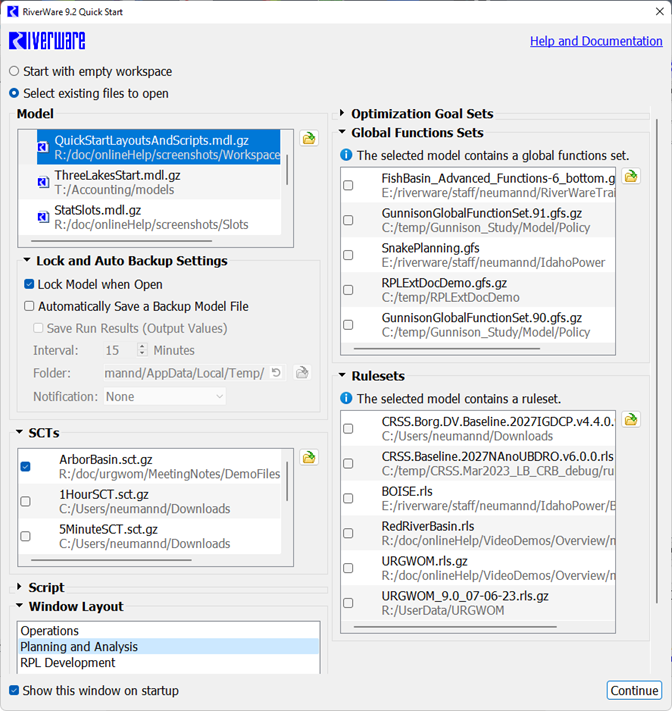
When finished selecting items, select Continue and RiverWare will open the selected files and show the workspace.
Tip: The Continue button becomes enabled once a model file has been entered or selected. If a recently opened model exists then it is selected by default when the Quick Start window first opens.
Pinning Items
For any of the file based items (model, RPL sets, and SCTs), you can pin commonly used items to the top of the list. Hover over the left side of the row and then select the pin icon:

The row will then move to the top area of the list and have a vertical pin:

Model Section
This section contains a selectable list of recently opened models and folders. This list is the same as that in the File and then Reopen Model menu in the workspace window.
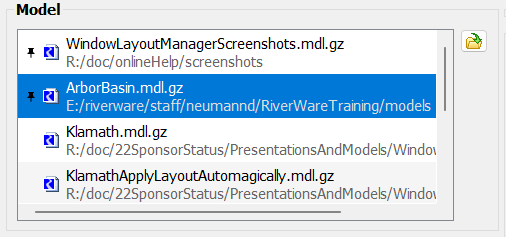
You can also use the Select folder button to locate a model file using a file chooser dialog.
Selecting a folder from this list opens a file chooser dialog at that location. Once you select a model, it is added to the list and is selected.
Tip: Make sure to select the model first as many of the items below come from the model including possible scripts and window layouts.
Lock and Auto Backup Settings
In the Lock and Auto Backup Settings, you can modify the model settings for locking the model while open and the auto backup save configuration.
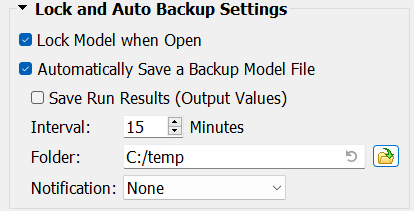
The settings are initially read from the model file so make sure to select it first. If you modify the settings, they will be applied after the model is opened. For more information see:
SCTs Section
In the SCTs section, optionally select one or more System Control Tables (SCTs). For more information, see System Control Table (SCT). The section presents a list of recently opened SCTs and a button to open a file chooser dialog. Selecting an item with the file chooser adds it to the list and selects it (with a check mark). All checked items will be opened when the Continue button is selected.
Scripts Section
In the scripts section, select one script or one script group to execute after the model loads. Select either Scripts or Script Groups and then the desired item.

Note: The scripts run after the model fully loads (but before Window Layout below are applied). If there is a script configured in the Script Manager to run as part of model load, it will run first, and then the script selected in the quick start will run after that.
Window Layout Section
In the Window Layout section, specify one Window Layout to apply:

The layout will be applied as the last step of loading the model.
For more information on Window Layouts, see Window Layouts.
RPL Sets Sections
In the Global Functions Sets, Rulesets, and Optimization Goal Sets section, optionally select one or more sets to open and load, where applicable. See About RPL Sets in RiverWare Policy Language (RPL) for more information on these sets.
Each section is arranged in a similar way: a list of recently opened items and a button to open a file chooser dialog. Selecting an item with the file chooser adds it to the list and checks it. All checked items will be opened when the Continue button is clicked.
The Global Functions Sets, Rulesets, and Optimization Goal Sets sections display a note informing that the selected model already contains an embedded set. In that case, no selection is necessary for that set and it will automatically be opened/loaded.

Opening Models With the File Chooser
To open a model, select File, then Open Model from the main workspace menu bar or select Open Model File.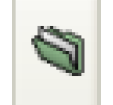 on the toolbar. A File Chooser dialog appears.
on the toolbar. A File Chooser dialog appears.
 on the toolbar. A File Chooser dialog appears.
on the toolbar. A File Chooser dialog appears.The file chooser filters by commonly used file extensions for Model Files, as follows:
• Model Files: *mdl, *.mdl.gz *.rw and *.rw.gz (default)
• gzip Files (*.gz)
• All *
For RPL sets, the filters include the following:
• Ruleset files (*.rls, *.rls.gz)
• Goal Set files (*.opt, *opt.gz)
• Global function sets (*.gfs, *gfs.gz)
• gzip files (*.gz)
• All (*)
In addition, the user can use asterisks (*) as wildcards in the File name to further filter. Once a file has been selected and the Open button has been selected, the cursor turns into an hourglass while the model is loading. Once the model is loaded a diagnostic window pops up with information regarding the date and time when the model was last saved, by whom the model was saved, and which version (release) of RiverWare. More information on model history is described in Model Info: History and Comments.
If the model is configured to display background images in one or more of the Workspace views, then after the model is loaded, RiverWare reads and displays the background image files. While RiverWare is loading these images, a gray placeholder background is displayed in the appropriate views and an animated Busy icon is shown at the bottom of the Workspace. All of the usual workspace interaction is still possible while images are being loaded.
Note: For many background images, the loading process is so brief that it is not noticeable.
Reloading Models
On the Workspace, selecting File, then Reopen Model gives the user previously opened models and directories. This is a quick and easy way to reopen a model. For rulesets there are options to Reopen and Reopen and Load previously viewed rulesets.
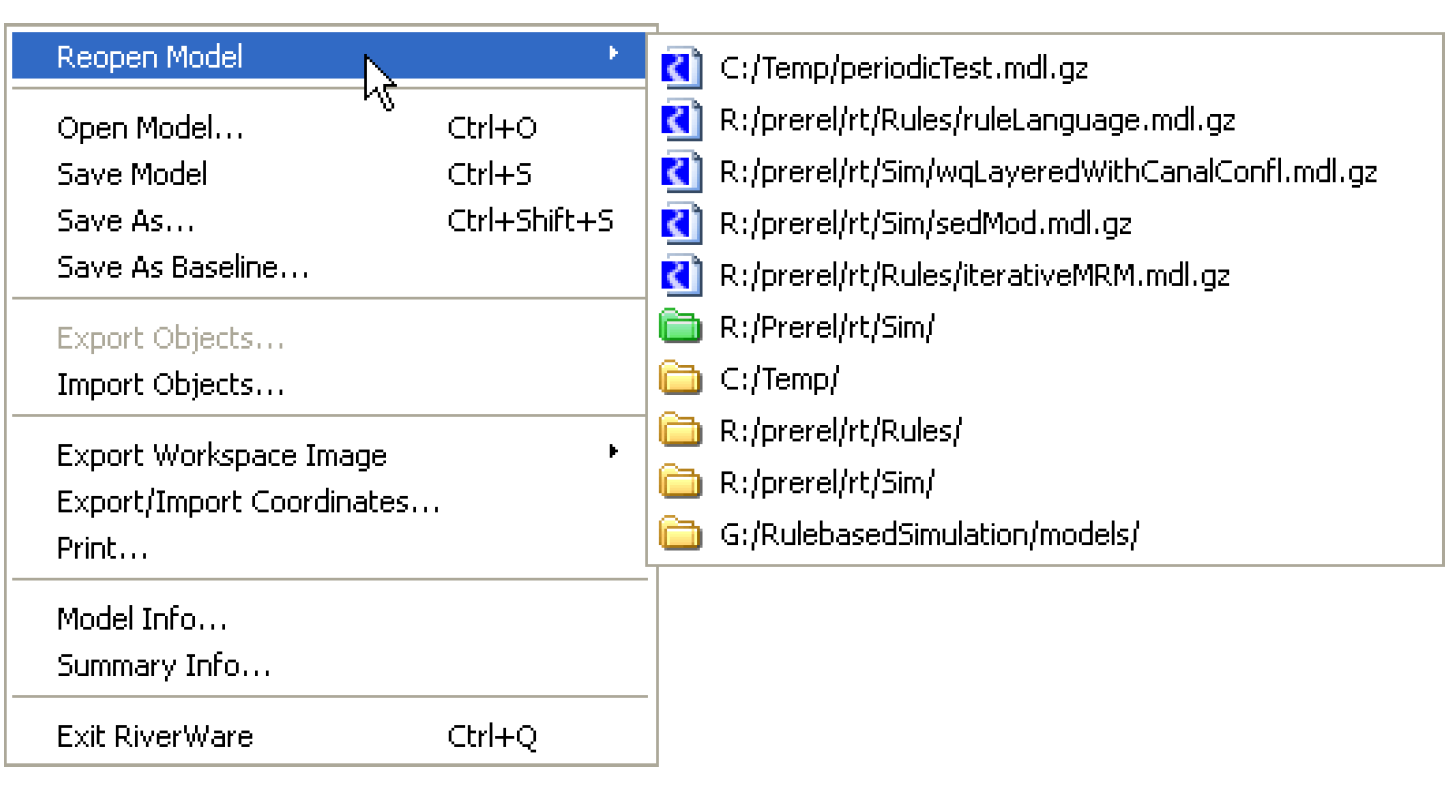
Listed in this menu are previously opened models and a list of recently accessed directories. Selecting a directory item (shown with a yellow folder icon) opens up a file chooser initialized to the specified directory. Also shown is a single user-configured default directory (for the specific type of file), based on an environment variable. This directory is shown as a green folder. If this is defined, the file chooser opened using the File, then Open menu will open to that default directory the first time within a RiverWare session. Table 3.1 lists supported environment variables.
Type of File | Environment Variable |
|---|---|
Model Files | RIVERWARE_DFLT_MODEL_DIR |
Rulesets (RPL) | RIVERWARE_DFLT_RULESET_DIR |
Optimization Rulesets | RIVERWARE_DFLT_OPTSET_DIR |
SCT Files | RIVERWARE_DFLT_SCT_DIR |
Revised: 01/05/2024